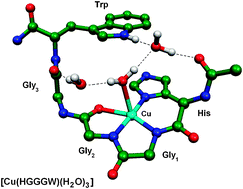The present paper shows how theoretically determined electron paramagnetic resonance (EPR) parameters can help in assigning the most favorable structure of Cu(II) complexes in octarepeat (OR) regions (PHGGGWGQ) of the prion protein (PrP). This could contribute to a better understanding of the molecular structure of the Cu(OR) complexes, as some features of such species in solution are still unclear. The present theoretical investigation on [Cu(II)(HGGG)] and [Cu(II)(HGGGW)] complexes was carried out to confirm the stability of relevant isomers, and in particular, to evaluate the hyperfine coupling constants (hcc) with 63Cu, 14N and 17O nuclei, as well as the g values. The hcc (and to a lesser extent the g components) are useful probes for checking whether the computed EPR parameters for specific isomers fit the experimental data, thus permitting the association of the observed spectra with a specific complex structure. The results obtained suggest that the Cu(II) ion in the [Cu(HGGG)] isomers prefers a square pyramidal coordination with three nitrogen atoms of the peptide and one carbonyl oxygen atom in the basal plane. Also the Cu(II) ion in the [Cu(HGGGW)] complex is penta-coordinated. The penta-coordination does not actually involve the tryptophan residue but an additional water molecule, forced to occupy the axial coordination position by a rather extended hydrogen-bond network, promoted by the tryptophan residue.
The comparison between the calculated and experimental values of EPR parameters allows one to suggest the assignment of the coordination mode of the Cu(II) ion in the considered peptide ligands. The computed values of the g components seem to be little affected by a particular coordination mode. In particular, the g∥ component is always underestimated by about 0.1 with respect to the experiment. The calculated values of the hcc, in contrast, are in acceptable agreement with the experimental values, in spite of the fact that the large size of the species under consideration forced us to accept a certain level of approximation in the computational procedure. Nevertheless, the present study must be considered as one of the first examples of truly ab initio calculations of EPR parameters for systems as large as the Cu(OR)-type complexes.


 Please wait while we load your content...
Please wait while we load your content...